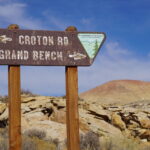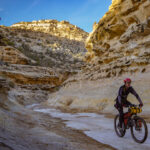Route Overview
Region
Miles
Days Out
Recommended Tire Size
Season
to late fall
Elevation Gain
Difficulty
5/10 Technical
Primary Surface(s)
47% gravel
Route Map
Route Details
This 170-mile loop follows the most seldom-traveled and arguably most scenic backcountry roads through Grand Staircase – Escalante National Monument through beautiful and remote Colorado Plateau country. Best ridden in late spring or autumn, this loop offers 3+ days of 4×4 riding and solitude.
This wonderous loop through the Grand Staircase-Escalante National Monument is on nearly 100% dirt, nearly 100% public lands, and through stunning Colorado Plateau canyon and plateau country (colorful smaller plateaus on the bigger Plateau!). The roads on this loop tend to be the quietest in the Monument and arguably are the most scenic. This route might be entirely on “roads,” but most are unimproved 4×4 roads that can be rocky, ledgy, soft, and rutted, so a mountain bike with 2.4-2.8″ tires is highly recommended. ATV use and vehicle traffic in general is minimal, so expect a quiet experience except on the short stretch on the busier and somewhat sandy Hole-In-the-Rock Road. This loop is best ridden in 3- to 5-days starting from either Big Water, AZ or Escalante, UT (parking is available at the BLM Visitors Centers in both communities), and the loop can be ridden in either direction. It’s described below in the clockwise direction. Before heading out, look carefully at the weather forecast – long stretches of these roads become absolutely impassible when wet. Finally, a free BLM backcountry permit is required for camping, and those can obtained in both Big Water and Escalante at the BLM Visitors Centers.
Starting from Big Water, this loop follows the sequence of Smoky Mountain Road, Highway 12, Hole-in-the-Rock Road, Left Hand Collet Canyon Road, Croton Road, and back again on the southern end of Smoky Mountain Road to Big Water. The first miles of the lollipop out to the loop are through gray shale badlands before the route climbs up the impressive Kelly Grade switchbacks to an incredibly scenic plateau surface above. At mile 33, “Drip Tank” is a generally reliable water source down a canyon (a 1/4-mile hike to a bedrock pool). The next 30 miles trend uphill toward the high point on the loop. The riding is demanding as the road is rocky, ledgy, and steep in places. Another generally reliable water source is at mile 46, an earthen stock pond near a ranch cabin (the stock pond is on public land, but please make sure to leave gates as found).
After the high point, the road descends toward Escalante, leaving the big views of the plateau tops behind and descending a canyon that can be sandy in places. The small community of Escalante sits at the mouth of the canyon, and riders can find restaurants, a small market, lodging options, and a BLM Visitors Center here. The route continues out of Escalante for a few miles on Highway 12 before turning south on Hole-in-the-Rock Road. This road sees more traffic as it provides access to the Monuments many popular slot canyon adventures above the Escalante River to the East. Hole-in-the-Rock Road tends to be sandy and washboarded, but the grasslands through which it passes are beautiful. After 16 miles, riders turn west into Left Hand Collet Canyon, one of the only drainages carved into the imposing eastern face of Fiftymile Mountain. The road up this canyon mostly follows the stream bed. Water often runs through the canyon in places, the road bed is sandy in places, and the canyon gets steeper and steeper before the road cuts steeply up to the plateau top above at Collet Top and the intersection with the Croton Road. Near the high point at Collet Top, riders have the option of returning to the earthen stock tank they passed miles earlier to fill up on water if needed – to the south along the Croton Road, it’s a long way to the next water source!
The Croton Road is arguably the most scenic and quietest road in the Monument as it snakes its way along the crest of the Burning Hills and then down to Sit Down Bench above Lake Powell. The burning hills are named for their smoldering coal veins. On still mornings, little smoke plumes can be seen rising from these veins, and there’s a fascinating one to explore just off route around mile 125 (but be careful – these burning veins give off hazardous hydrogen sulfide gas, and the ground can be quite unstable!). Past these burning coal veins, the route plunges toward Glen Canyon, with Navajo Mountain and seemingly endless canyon country looming in the distance to the south. Once on Sit Down Bench, the terrain becomes mellower, and the road condition gradually improves as it winds west toward the intersection with Smoky Mountain Road.
Water sources included in this route information are generally reliable in spring and after a decent late-summer monsoon season, but they may be dry after particularly dry periods. Carry far more water than is needed.
Feedback from riders who have been out on this loop consistently includes, “those roads were far more demanding than I was expecting!” These roads are rough, the terrain is demanding, and the miles take longer than most expect . . . but it’s so worth the effort.
- Paved: 3%
- Smooth Gravel: 20%
- Rough Gravel: 27%
- 4×4 Road: 50%
- Singletrack: 0%
See the “Additional Route Information” section of the route website for more information on water, camping, public lands, safety considerations and more.
- This route is part of a collection of routes on the Backcountry-MTB website. Please see more details on the route webpage.
- Please find the route on Ride with GPS: Grand Staircase-Escalante Nat’l Monument High Plateaus Loop
Kurt Refsnider created and stewards this route.
Kurt is Bikepacking Roots’ Routes Director and co-founder. He’s dedicated years to developing bikepacking routes and guides for other riders including the Western Wildlands Route, the Bears Ears Loops, the Northwoods Route, and many shorter routes. His passion is riding in wild, remote landscapes, and many of his route visions aim to help others experience places, connect to those landscapes, and recognize why the conservation of such places is so important.
Please get in touch with any updates on route conditions that may be relevant to other riders.
Unfortunately, Kurt is not available to help folks with trip planning questions.
Please submit your questions and comments on the route to Kurt through the comment form below.
This route traverses the traditional lands of the Southern Paiute, Pueblos, and Ute.




































